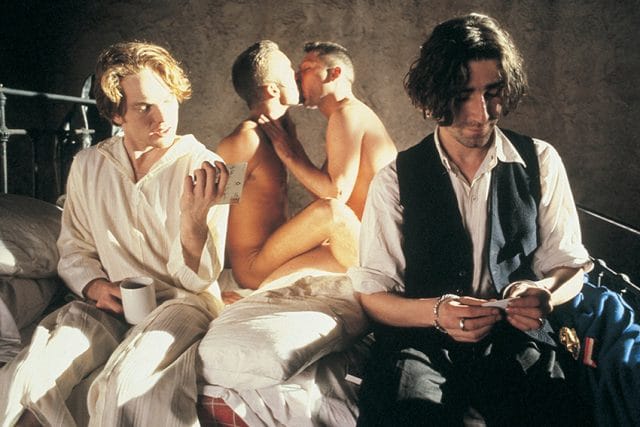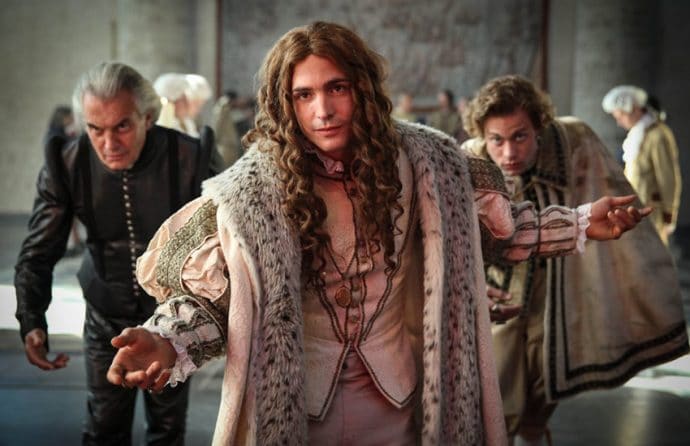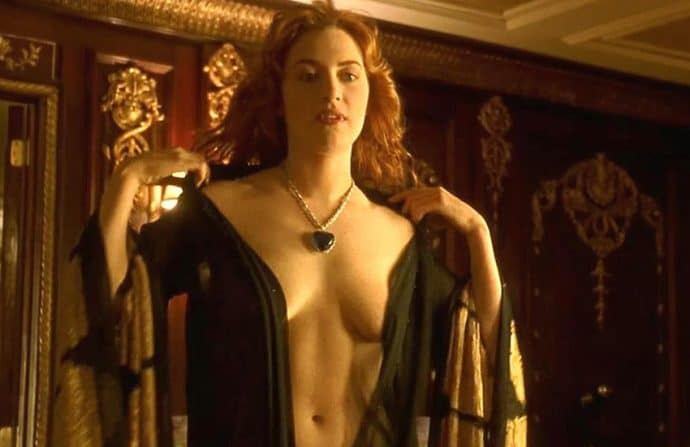
Secret love lives, stormy reigns and grisly murders
England’s ‘gay’ kings and queens defied society – during perhaps the most homophobic era of human history – to have same-sex lovers.
Of 41 monarchs since William The Conqueror, we’ve identified seven who were likely lesbian, gay or bisexual. That’s an incredible 17%. And they include some of the most famous rulers in British history.
This is the incredible history of their secret love lives, stormy reigns, tragic sicknesses and grisly murders.
King William Rufus (1087 – 1100)
 Knights in the TV series MerlinBBCHandsome men were promoted in William II’s court, just as in the TV series Merlin.
Knights in the TV series MerlinBBCHandsome men were promoted in William II’s court, just as in the TV series Merlin.
William II was ‘addicted to every kind of vice, particularly lust and especially sodomy,’ according to Frank Barlow, the leading medieval historian.
William II came to the throne just 21 years after his father, William I, had conquered England. And the country was still sharply divided between the English people and their new Norman overlords.
He made himself unpopular through his taxes and by imposing the death penalty on people who hunted deer in great swathes of forest he claimed for royal use.
But he was also a brave general. He extended his rule into Wales, brought the Scottish King Malcolm under his influence and established peace in Normandy.
His red face earned him the nickname William Rufus and he had a paunch. But he filled his court with attractive young men.
They wore fashionable pointed shoes and grew their hair long. He is said to have promoted these men on the basis of their performance in bed, rather than their talent.
Unusually for a monarch, he was never married and had no children.
Further evidence for his homosexuality comes from his squabble with the leader of the English church – Anselm, the Archbishop of Canterbury.
Anslem was already smarting at William’s tactic of delaying the appointment of new bishops so he could take money from the church’s estates.
But he allegedly went further, attacking the ‘effeminacy’ of William’s courtiers and calling for sodomy to be made illegal. Attacking these courtiers is as close as the archbishop could come to challenging the king himself, without being accused of treason.
William was shot through the heart with an arrow while hunting in the New Forest. Some claimed his murder was God’s revenge. And his brother, Henry I, who succeeded him, forced his courtiers to cut their hair.
Richard The Lionheart (1189-1199)
 Chandler Maness as Richard the Lionheart in the film Rebellion.RebellionChandler Maness as Richard the Lionheart in the film Rebellion.
Chandler Maness as Richard the Lionheart in the film Rebellion.RebellionChandler Maness as Richard the Lionheart in the film Rebellion.
Richard I is one of England’s most famous kings, even though he spent only six months of his 10 year reign in the country.
The best evidence for his homosexuality came from his youth, when he was still Duke of Aquitaine and in open revolt against his father, Henry II.
To defend Aquitaine, the 22-year-old Richard allied himself with Philip, the teenage King of France.
The chronicler, Roger of Hovden, who knew Richard personally, says Philip ‘honored’ Richard.
He adds: ‘They ate every day at the same table and from the same dish, and at night their beds did not separate them.’
Modern historians have claimed this was diplomacy – that getting in bed with each other was merely symbolic. But that doesn’t explain Roger of Hovden’s next comment:
‘And the king of France loved him as his own soul; and they loved each other so much that the king of England was absolutely astonished at the passionate love between them and marvelled at it.’
Richard was a towering figure, up to 195cms (6’5”) tall, and reportedly very attractive with strawberry blond hair, light eyes and a pale complexion. No surprise the younger Philip may have been attracted to this courageous warrior.
Once king, Richard joined Christian soldiers in the Third Crusade to conquer Jerusalem from the Muslims. Despite early military success, he failed in this quest.
But the crusade provides more evidence for his sexuality. He apparently had one male lover, a young knight and fellow crusader, Raife de Clermon, who he freed from Muslim captivity.
And he is thought to have had sex with women too, even raping them. Richard rarely saw his wife, who had been forced on him in an arranged marriage. But he had at least one illegitimate son.
Finally, it is likely he admitted his gay affairs as part of church ceremonies where he publicly ‘confessed’ his ‘sins’. This was a common act of Christian faith at the time and doesn’t mean he was ashamed of his actions. In fact, it shows he probably didn’t bother to hide what he did.
So overall, the evidence points to him being bisexual.
On his way home from the crusade, he was captured, forcing England to pay a ransom for his return.
The costs of his war and ransom were a vast drain on English wealth. And to make matters worse, he spent most of the rest of his reign outside his kingdom, fighting Philip – now very much an ex-lover.
So if he was a bad king, why is he so popular today? Perhaps he owes it to the myth of Robin Hood. The swashbuckling legend of minstrels and ‘stealing from the rich to give to the poor’ depicts Robin supporting Richard.
Edward II (1307-1327)
 Peter Hanley as Edward II in the film Braveheart.BraveheartPeter Hanley as Edward II in the film Braveheart.
Peter Hanley as Edward II in the film Braveheart.BraveheartPeter Hanley as Edward II in the film Braveheart.
Edward II is the most famously ‘gay’ British monarch. Novels, poetry, plays and films have told of his tragic love and horrific murder.
He was a teenage prince when a young noble, Piers Gaveston, joined his household. Edward I thought Gaveston’s conduct and military skills would be a good influence on his son.
Gaveston was around Prince Edward’s age and most historians believe they became lovers. They may have been ‘wedded brothers’ – a sort of friendship agreement likened to a church-approved same-sex partnership ceremony.
Eventually King Edward I exiled Gaveston. He may have been alarmed by the pair’s closeness or simply punishing his son for something else by driving his friend away.
When his father died and Edward was crowned, he married Isabella of France to end tensions between England and France. But he also invited Gaveston back from banishment.
Soon Gaveston angered Edward’s nobles by his special access to the king and alleged arrogance. They forced Edward to banish Gaveston again.
But the king invited his lover back and repealed laws that restricted his powers. And he showered Gaveston with gifts and land.
Eventually the nobles started an open civil war against their king. They hunted down Gaveston and executed him.
Edward II found new supporters in the Despenser family. And he may have had a relationship with Hugh le Despenser the Younger.
When the nobles caught the younger Despenser, they hanged, drew and quartered him. During the execution, his penis was cut off and burned, perhaps to punish his sodomy and heresy.
Edward’s queen, Isabella, now gained power and he abdicated in favor of their teenage son, who became Edward III.
Edward II was eventually murdered in Berkley Castle. A rumor circulated that his executioner inserted a red hot poker into his anus, again to punish his homosexuality. Historians now dispute that but it has become the most famous legend about a gay king.
Richard II (1377-1400)
 Richard II depicted in the BBC’s The Hollow Crown.BBCRichard II depicted in the BBC’s The Hollow Crown.
Richard II depicted in the BBC’s The Hollow Crown.BBCRichard II depicted in the BBC’s The Hollow Crown.
Richard was just 10 years old when he became king. Therefore leading nobles ran the country on his behalf.
But when England’s peasants revolted during his teenage years, he stepped up.
The poor had suffered through the Black Death and subsequent plagues. And they were angered by their landlords and a new poll tax.
When Wat Tyler led the Peasants’ Revolt to London, they burnt the Savoy Palace and killed top nobles. They even demanded the end of serfdom – the system which kept them in poverty and made their lords rich.
Richard sheltered in the heavily fortified Tower of London. But he realized he didn’t have enough men to take on the peasants. So, aged just 14, he rode out to meet the peasants and negotiate. When a scuffle broke out, he calmly called out to the crowd ‘I am your captain, follow me’ and led the mob away.
It was the high point of his reign. As he got old enough to rule for himself, he surrounded himself with unpopular favorites.
Robert de Vere, the Earl of Oxford, was one of them. And the king and de Vere may well have had a sexual relationship.
In 1385 Richard made him Marquess of Dublin, and the next year Duke of Ireland. These gifts were exceptional. The king invented the marquess title to honor de Vere. And only close royal relatives ever became dukes, not regular nobles.
No wonder de Vere became unpopular. Plotters saw him stripped of his titles and sentenced to death in 1388. He eventually died in 1392.
But that wasn’t the end of the story. Three years later, Richard II brought de Vere’s body home for burial. Many nobles refused to attend, because they so hated him.
But the king ordered his coffin opened. He kissed his friend’s hand and gazed on his face one last time.
Richard II was definitely handsome. But writers have noted his ‘feminine aspect’ alongside ‘blond hair’ and ‘stuttering, lisping speech’.
One contemporary writer noted his extravagance in his ‘entertainments and dress’ saying he stayed up all night drinking with friends. They also engaged in ‘excesses that are not to be named’ – possibly gay sex.
The nobles became unhappy with Richard and his new favorites and forced him out.
Adam of Usk, who sat on the committee on how the king should be removed from power, refers in his Chronicle to Richard’s ‘sodomies’ as a reason for the deposing him.
He was imprisoned in 1399 and died four months later.
James I (1603 – 1625)
 James I depicted in a National Theatre production.National TheatreJames I depicted in a National Theatre production.
James I depicted in a National Theatre production.National TheatreJames I depicted in a National Theatre production.
Some historians dispute James I’s sexuality but people at the time certainly knew. They said: ‘Elizabeth was King, now James is Queen.’
His reign was a turning point, uniting two crowns. He was already King James VI of Scotland when the English Queen Elizabeth I died. As she had no children, he succeeded her as her closest living relative, becoming James I of England.
His reign saw the British colonization of the Americas and Ulster.
He saw off the Gunpowder Plot to blow up parliament, still celebrated every 5 November across Britain with fireworks displays.
And he directed the country’s great scholars to translate the Bible into English. The King James Bible is one of the greatest achievements of English literature and culture.
But fewer people know about this scholar king’s series of favorites – and probable lovers.
These relationships started early. At the age of 13 he fell for his 37-year-old cousin Esme Stuart, who he later made Duke of Lennox.
One observer said James was ‘in such love with him as in the open sight of the people often he will clasp him about the neck with his arms and kiss him’.
Later in life he enjoyed the company of young, pretty men himself.
One was the 17-year-old Robert Carr, who he made Earl of Somerset.
When Carr went off James after several years, the king wrote him a letter. In it he complained Carr was ‘withdrawing yourself from lying in my chamber, notwithstanding my many hundred times earnest soliciting you to the contrary’.
When he broke up with Carr, he took up with George Villiers, who he made the Duke of Buckingham.
One contemporary poet, Théophile de Viau, wrote plainly: ‘And it is well known that the king of England / fucks the Duke of Buckingham.’
And the king himself wrote to Villiers: ‘I naturally so love your person, and adore all your other parts.’
James also liked women. He married Anne of Denmark and was infatuated with her. But after they had eight children, the relationship cooled. He reportedly cheated on her with at least one other woman.
But this bisexual king was no LGBTI hero. In fact he was a hypocrite. He insisted on harsh punishment and no mercy for sodomy.
But his memorial in Westminster Abbey, where Britain’s greatest statesmen are buried, is a testimony to his sexuality. His effigy is flanked by that of two of his lovers. The magnificent tomb of George Villiers is on his left and his first love, Esme Stuart’s, is on his right.
William of Orange (1689-1702)
 William of Orange in the film, The Admiral.AdmiralWilliam of Orange in the film, The Admiral.
William of Orange in the film, The Admiral.AdmiralWilliam of Orange in the film, The Admiral.
William III initially ruled as joint sovereign with his beloved wife Mary. But after she died, rumors of his homosexuality started.
The two had come to the throne because the previous Catholic king, James II was so unpopular. Protestant William had married Mary, James II’s daughter, and they invaded in what became known as the ‘Glorious Revolution’.
But when Mary II died of smallpox on 28 December 1694, questions over the legitimacy of William’s kingship resurfaced. His popularity plummeted.
And during that decade, satirical pamphlets from his enemies alleged he had homosexual inclinations. They based the claims on his close male friendships and his lack of a mistress.
Two Dutch courtiers are among his most likely lovers. He gave British lands and titles to both Hans Willem Bentinck and Arnold Joost van Keppel. Naturally, English courtiers were jealous.
Keppel in particular sparked suspicion. He was 20 years younger than William, very handsome and William promoted him from royal page to earl very quickly.
William himself vigorously denied the rumors. Gay sex was, after all, still a crime.
He said: ‘It seems to me very extraordinary that it should be impossible to have esteem and regard for a young man without it being criminal.’
But now people are more certain. The controversial Orange Order in Northern Ireland was named for William and denied his bisexuality for years. Now they accept it is an ‘open issue’.
And the future Queen Anne, the next monarch, had few doubts. After her sister, Mary II, died, she didn’t worry about her brother in law, William II marrying again and having more children.
She said his heart ‘be not for women’ and had been taken by a nobleman.
Anne (1702 – 1714)
 Kate Winslet will star as Sarah in a new drama based about Queen Anne.TitanicKate Winslet will star as Sarah in a new drama based about Queen Anne.
Kate Winslet will star as Sarah in a new drama based about Queen Anne.TitanicKate Winslet will star as Sarah in a new drama based about Queen Anne.
That same Queen Anne is our final entrant into the line of LGBTI monarchs.
England and Scotland were formally united during her reign. So Anne became the first ever Queen of Great Britain.
Parliament had been gaining more power from the monarch for centuries. But two political parties came to dominate it during Anne’s time on the throne. That ‘two party system’ continues today.
Anne was most likely bisexual. She was devoted to her husband Prince George of Denmark. She became pregnant 17 times with him but tragically all her children died.
But everyone remembers Anne for her passionate relationship with her lady-in-waiting. Sarah Churchill was the wife of the Duke of Marlborough who achieved military success for Anne early in her reign.
The two women got together while Anne will was still a princess. Sarah was beautiful and charming, while Anne was plain and often sick. They shocked some by using pet names for each other. And Anne broke with protocol by talking with her lady-in-waiting as an equal.
Sarah was assertive and Anne rather shy. And Sarah didn’t hesitate to use that to her advantage. She ‘stage managed’ the powerful woman who so adored her.
So many public figures knew about their relationship they they would shower attention on Sarah in the hope she would influence the queen.
But Sarah had a quick temper too and wasn’t afraid to disagree with the queen. She fell in and out of favor. And eventually she pushed it too far.
Anne dumped Sarah and replaced her with Abigail Masham. It must have hurt Sarah, who had introduced Abigail to court and treated her ‘like a sister’. She lashed out, hinting that Abigail and the queen were lovers. She even implied Anne regularly had sex with her ladies.
In the end, Anne’s fate is rather sad. She died aged 49, having lost both her children and the love of her life. Sarah, however, lived until 84 and died one of the richest women in Europe.







